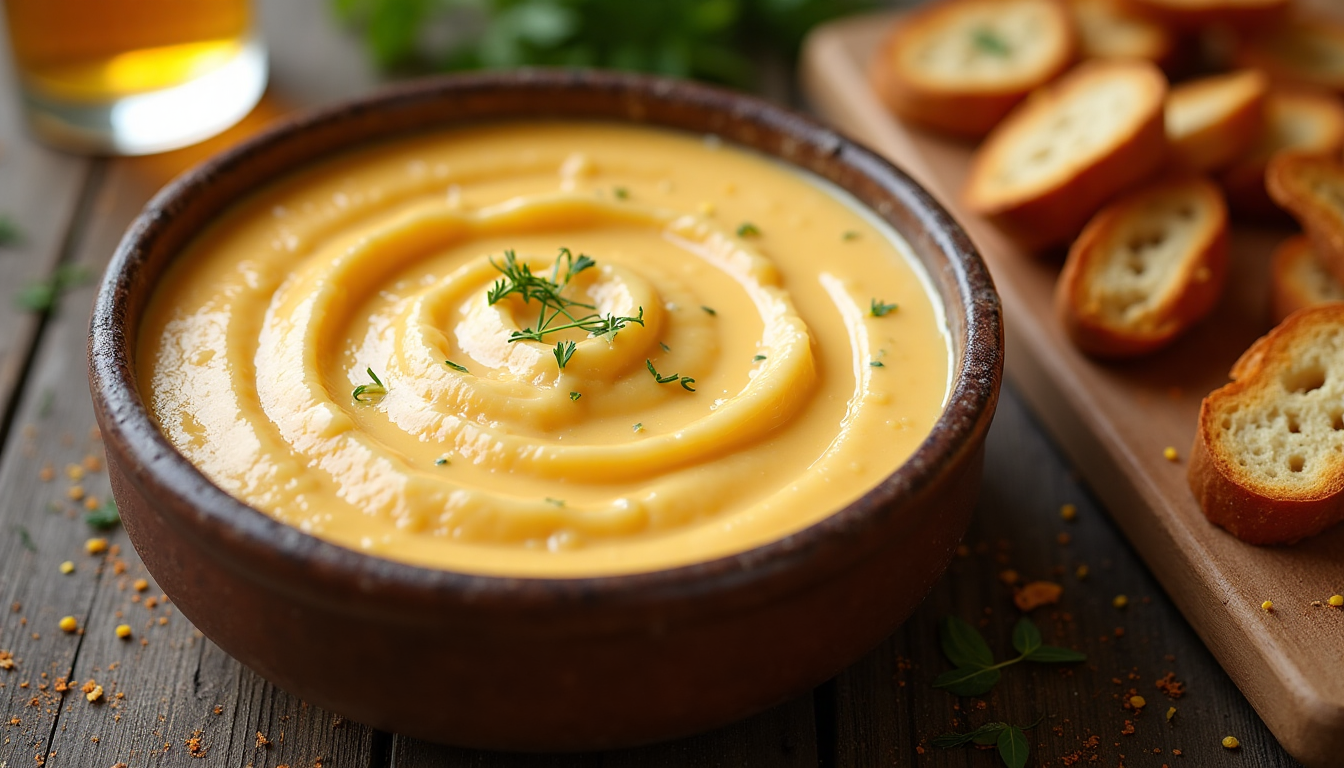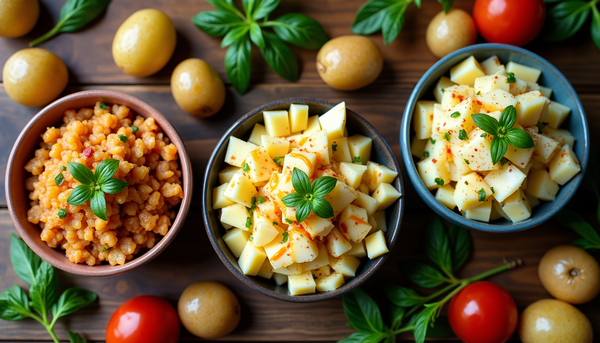The Science of Perfect Beer Cheese Dip

The Science of Perfect Beer Cheese Dip: Why Your Roux Matters More Than Your Recipe
I'll be honest with you – my first attempt at beer cheese dip was an absolute disaster. Picture this: me, confidently dumping pre-shredded cheese into boiling beer, watching in horror as it turned into what can only be described as alcoholic rubber cement. My friends still bring it up at parties, and honestly? They should. It was that bad.
But here's the thing about spectacular kitchen failures – they teach you more than any success ever will. That stringy, grainy mess sent me down a rabbit hole of food science that completely changed how I approach cheese-based sauces. And now? Well, now my beer cheese dip has become somewhat legendary in my circle (for all the right reasons this time).
The Chemistry Behind That Perfect Creamy Texture
Let's talk science for a hot minute, because understanding what's actually happening in your pot is the difference between silky perfection and chunky disappointment.
When you heat cheese, you're essentially playing with protein structures called casein. Heat them too fast or too hot, and these proteins clump together faster than you can say "game day snack," squeezing out all the fat and moisture. That's how you get the dreaded cheese seize-up – those rubbery clumps that no amount of whisking can save.
The secret weapon? A proper roux.
That butter-flour combo isn't just thickening your dip – it's creating a protective network around those cheese proteins. The flour provides emulsification power (thanks, starch!), while the fat from butter helps everything stay smooth. It's like giving your cheese a safety net before it takes the heat plunge.
Ingredient Intelligence: Why These Specific Choices Matter
The Beer Factor
Okay, let's address the elephant in the room – does the beer type actually matter? Short answer: absolutely yes. Long answer: it's all about balancing bitterness, sweetness, and that magical thing called umami.
IPAs bring hoppy bitterness that cuts through rich cheese beautifully. I'm personally obsessed with how a citrusy IPA plays against sharp cheddar – it's like a flavor seesaw in the best possible way. But if you're team mellow, a wheat beer or lager won't compete with your cheese choices.
Here's what I learned from way too many experiments: avoid anything too sweet (looking at you, fruit beers) or too coffee-forward (sorry, stouts). You want something that'll enhance without overwhelming.
The Cheese Game-Changer
Can we talk about pre-shredded cheese for a second? I know it's convenient. I know it's sitting right there in the dairy aisle, calling your name. But those anti-caking agents (usually cellulose) are the enemy of smooth cheese sauce. They literally prevent proper melting.
My current obsession is a 60/40 split of aged white cheddar and smoked gouda. The cheddar brings that sharp, tangy backbone while the gouda adds this incredible smoky sweetness. But honestly? Experiment. That's half the fun.
Gruyère makes things nutty and sophisticated. Fontina goes full-on creamy. Monterey Jack plays well with others. Just remember – the sharper your cheese, the more complex your final flavor.
The Unsung Heroes
Dijon mustard isn't just there for flavor (though that tangy kick is chef's kiss). The acids in mustard actually help with emulsification. Same deal with Worcestershire – those anchovies aren't just adding umami, they're contributing to the overall stability of your sauce.
Smoked paprika? That's pure flavor genius. It bridges the gap between your beer's maltiness and your cheese's richness with this subtle smoky note that makes people go "what IS that?" in the best way.
The Technique That Changed Everything
Here's where I'm gonna get a little nerdy, but stick with me because this part is crucial.
Step 1: Respect the Roux
Medium heat, people. Not medium-high, not "eh, close enough" heat. Medium. Melt your butter completely, whisk in that flour, and let it cook for about a minute. You want to cook out the raw flour taste without browning (unless you're going for a nutty flavor, which... okay, that's actually not a terrible idea for next time).
Step 2: Liquid Integration Magic
Add your beer and milk gradually while whisking. I know every recipe says this, but there's real science here – you're building an emulsion. Too much liquid too fast = lumps. Trust me, I've been there.
Let this mixture come to a gentle simmer. You'll see it thicken slightly – that's your roux doing its job.
Step 3: The Cheese Ceremony
This is where most people mess up. Turn your heat to LOW. Like, as low as it goes. Add cheese in small handfuls, whisking constantly between additions. Each handful should completely melt before you add the next.
Why? Because patience here literally makes the difference between Instagram-worthy smoothness and... well, my first attempt.
Creative Variations That Actually Work
Once you've mastered the base, the fun really begins. Here are some combinations I've tested (and my friends have devoured):
The "Loaded Baked Potato" Version Add crispy bacon bits, chives, and a dollop of sour cream on top. Use a mild beer and extra sharp cheddar. It's comfort food inception.
The "Mexican Street Corn" Twist Stir in some diced jalapeños, lime zest, and finish with cotija cheese and paprika. Pair with Mexican lager. Serve with lime-dusted tortilla chips and watch people lose their minds.
The "Buffalo Wing Aftermath" Hot sauce (obviously), blue cheese crumbles, and celery salt. Best with a crisp lager to cool things down.
The "Oktoberfest" Special German beer, swiss and gruyère blend, whole grain mustard instead of Dijon, and pretzel roll dippers. Basically Bavaria in a bowl.
Troubleshooting Your Way to Success
If your dip gets grainy: You heated it too fast or too hot. Next time, lower heat and more patience. For this batch, try whisking in a splash of cold milk off the heat.
If it's too thick: Thin with warm milk or beer, one tablespoon at a time.
If it's too thin: Make a tiny bit more roux in another pan and whisk it in.
If it breaks (oil separating): Take it off heat immediately and whisk in cold milk. Sometimes you can save it, sometimes you learn for next time.
The Real Talk About Timing
That 15-minute claim? It's legit, but only if you have everything prepped and ready. Grate your cheese beforehand. Have your liquids measured. Because once you start the roux, you're committed to seeing it through.
Also, this dip has a personality – it's best fresh and hot. It'll keep warm in a slow cooker for parties, but don't expect the same silky texture after sitting around. Not saying it's bad (it's still cheese and beer, after all), just... different.
Let's Get Interactive
I'm genuinely curious about your beer cheese adventures. What's your go-to beer choice? Have you tried any wild cheese combinations that actually worked?
And be honest – have you had any spectacular failures like my rubber cement incident? Drop a comment because I'm always looking for new "learning experiences" to try.
If you end up making this, tag me on social. I love seeing different interpretations, and honestly, some of you come up with combinations I never would've thought of.
The Bottom Line
Beer cheese dip isn't just a recipe – it's a canvas. Once you understand the science behind the roux, the importance of temperature control, and why certain ingredients work together, you can customize it endlessly.
Start with the basic technique I've outlined, then make it yours. Maybe your thing is extra sharp cheddar with a hoppy IPA. Maybe you're all about that mild cheese, wheat beer combination. There's no wrong answer as long as you respect the process.
And hey, if your first attempt isn't perfect? Welcome to the club. Mine was legendarily bad, and look how that turned out. Sometimes the best learning comes from the biggest disasters.
Now go forth and create some cheesy magic. Your taste buds (and your friends) will thank you.
What's your planned beer and cheese combo going to be? Let me know in the comments – I might just have to steal it for my next experiment.




